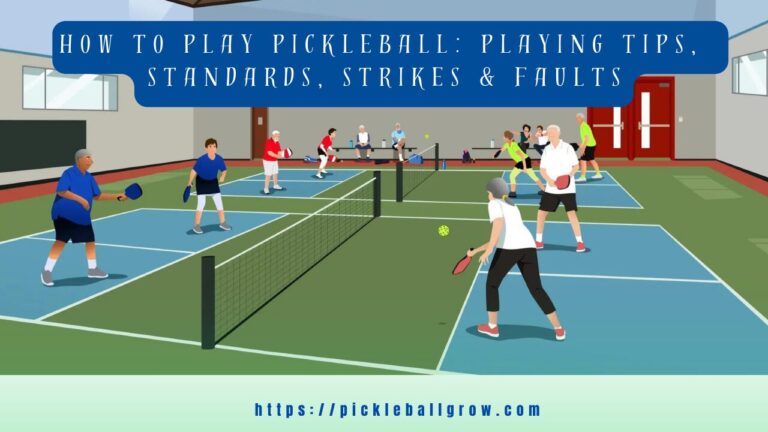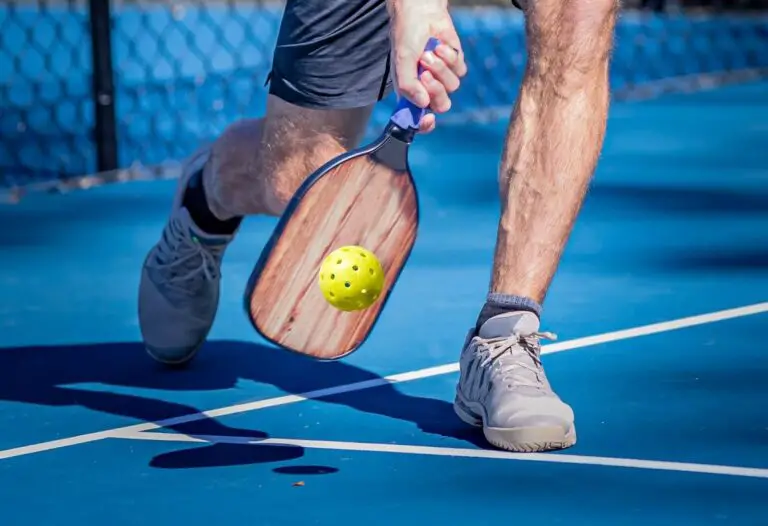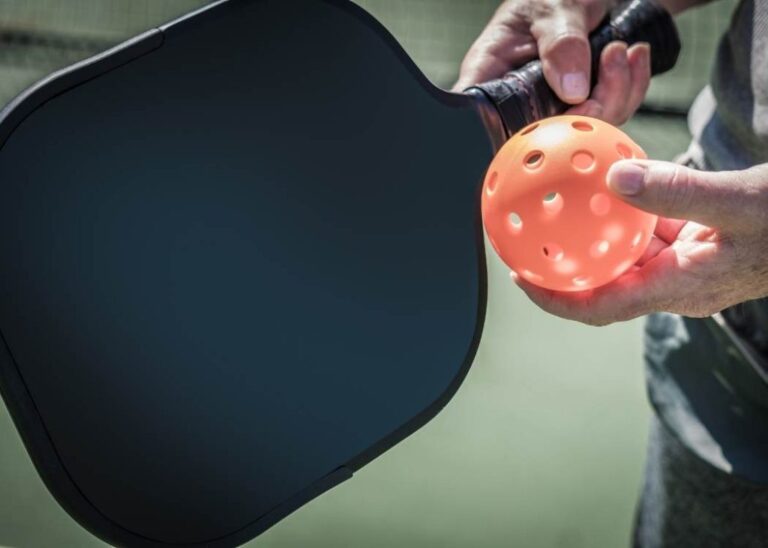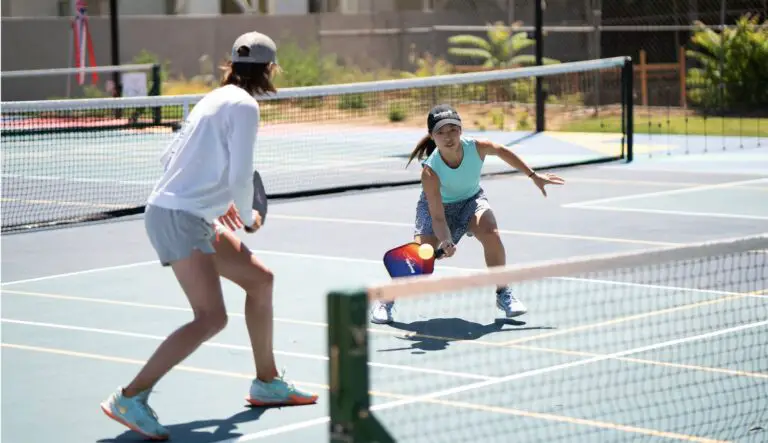How to keep score in pickleball singles?
Before knowing the answer to the main question “How to keep score in pickleball singles” let’s explore what is a single game in pickleball. Pickleball, usually played in a best-of-three-sets structure, requires players to aim for 11 points in each set. The serve initiates from the right-hand side, diagonally targeting the opponent’s service court, setting the tone for the thrilling volleys to unfold.
In paddle sports like pickleball, players can choose between singles or doubles matches. Singles involve a head-to-head matchup, while doubles comprises two teams of two players each. Playing singles in pickleball, although having more straightforward rules, demands significant physical effort.
With one player covering the entire court, akin to tennis, it necessitates rapid reactions and swift movements due to the game’s lower bounces and delicate shots. However, there’s an alternative singles variation called “skinny singles,” designed to lessen the cardiovascular demands on players.

Playing singles in pickleball involves distinct rules and strategies. Understanding the serving dynamics is crucial for gameplay. Here are three essential serving guidelines that shape the scoring and sequence in singles matches:
- The game initiates with the serve from the right-hand side.
- After winning the initial serve, the player switches to serving from the left-hand side.
- The serving player continues alternating between the right and left sides until a fault occurs, transferring the serve to the opponent.
As of now, you know what exactly a single pickle score is. Now it’s the right time to see How to keep score in pickleball singles. Let’s have a look!
How to Keep Score in Pickleball Singles?
Get ready for the most interesting question of the blog How to keep score in pickleball singles. The mentioned strategies below will help you know all about keeping score in pickleball singles. Let’s have a look!
Strategy 1: Establish Fundamental Pickleball Skills
Before diving into specific strategies, prioritize mastering fundamental pickleball skills. Focus on refining your serve, return, and the delicate dink shot; essential tools that form the backbone of compelling gameplay.
Strategy 2: Position yourself near the Center Line
Strategically positioning yourself near the centerline offers a substantial advantage. This placement allows broader court coverage and applies pressure on your opponent. Maintaining control over the center limits your opponent’s angles and compels them to attempt more challenging shots.
Strategy 3: Take charge of the Rally
The third shot drop, a key tactic in singles play, involves delivering a soft shot that lands in the non-volley zone (kitchen) after serving. This forces your opponent to hit the ball near the net, creating an opportunity for you to advance and take charge of the rally from a more advantageous position. Keeping your opponent guessing is crucial. Vary your shots by altering pace, spin, and placement. A mix of power shots and finesse (such as dinks) disrupts your opponent’s anticipation, creating a more unpredictable game. Strive for a balance between aggressive offense and controlled play to maintain dominance on the court.
Strategy 4: Observe your opponent’s positioning
In singles pickleball, anticipation is a game-changer. Observing your opponent’s positioning, body language, and shot tendencies allows you to foresee their moves. Early recognition helps you swiftly navigate the court, enhancing your ability to respond effectively to their shots.
As your experience grows, study your opponent’s strengths and weaknesses. Adapt your strategy by exploiting their vulnerabilities and avoiding shots that play into their strengths. This tactical awareness empowers you to adjust your gameplay dynamically, maximizing your chances of success on the court.
Strategy 5: Focus on Controlled Hits
For beginners, consistency triumphs over flashy shots. Focus on controlled hits that keep the ball in play. Minimize unforced errors and unnecessary risks, compelling your opponent to make mistakes. Consistency acts as a solid foundation, increasing your chances of winning rallies.
Strategy 6: Identify the Server And Receiver
To keep score accurately in Pickleball singles, it’s crucial to identify the server and receiver correctly. The server initiates each point while the receiver returns the serve. The server’s score is always called first, followed by the receiver’s score.
Strategy 7: Remember Scoring System
Pickleball employs a unique scoring system known as “rally scoring.” This means that points can be won or lost by both the server and the receiver. Here’s a breakdown of how points are awarded:
- Server Wins: If the server wins the rally, it gains a point and continues to serve from the same side.
- Receiver Wins: If the receiver wins the rally, they earn a point and become the new server.
- Faults: A fault happens when a player makes an error, like as hitting the ball out of boundaries or into the net. In this case, the opposing player is awarded a point, and the server changes sides.
Strategy 8: Use The 7-Point Rotation
In singles pickleball, players switch sides at specific score intervals. The rotation occurs when the combined scores of both players reach 7 points. For instance, if the server has 5 points and the receiver has 2, a change of sides takes place during the next break in play.
To ensure clarity and avoid confusion, it’s crucial to announce the score before each serve. Utilize a clear and concise format by stating the server’s score first, followed by the receiver’s score. For instance, if the server holds 8 points and the receiver has 6, announce the score as “8 serving 6” before the serve begins. This practice helps maintain a clear understanding of the game’s progression.
Tips to Keep Score In Pickleball Singles
As for now, you know all about the blog, now I’m giving tips for you to help you know more good on How to keep score in pickleball singles. Enhance your scoring proficiency with these supplementary pointers:
- Stay Focused: Pay close attention to each point, ensuring precision in scoring throughout the game.
- Clear Communication: Effectively communicate the score to your opponent before each serve and verify if needed to prevent misunderstandings.
- Utilize Tools: Consider using a scorecard or a scoring app for a more organized and efficient scoring method.
- Seek Guidance: If uncertain about specific rules or situations, refer to the official rulebook or consult experienced players or referees for clarification.
Score in Pickleball Singles vs Doubles
The scoring dynamics between singles and doubles pickleball matches exhibit nuanced differences.
- In singles play, the focus revolves around individual performance. Each player serves and scores independently, with the server’s score announced first, followed by the receiver’s. The 7-point rotation, occurring when the combined scores of both players reach 7, prompts players to switch sides, ensuring a fair distribution of court positioning based on individual scores.
- Conversely, doubles pickleball centers on teamwork and coordinated efforts. Both players on a team take turns serving, and the team’s score is announced before the opposing team’s score. The 7-point rotation in doubles triggers a side switch when the combined scores of both teams reach 7, emphasizing collective performance and fairness within the team dynamic. This system aims to maintain balance by ensuring both teams equally experience changes in court positioning based on their combined scores.

Read more: Pickleball Singles
FAQs
What’s the significance of accurate scoring in pickleball singles?
Accurate scoring ensures fairness and maintains the competitive spirit of the game. It allows players to track progress effectively, determining the winner based on precise points earned.
How does the 7-point rotation impact gameplay in singles pickleball?
The 7-point rotation prompts players to switch sides when the combined scores reach 7 points. This practice ensures fairness in court conditions for both players.
How do players determine the roles of the server and receiver during scoring?
The server initiates each point while the receiver responds to the serve. Scoring starts with the server’s score announced first, followed by the receiver’s.
Can faults affect the scoring dynamics in pickleball singles match?
Certainly, faults such as hitting the ball out of bounds or into the net award a point to the opponent and often result in a change of server sides.
What strategies aid in effectively communicating the score during play?
Clear and concise communication, stating the server’s score first, followed by the receiver’s, prevents confusion before each serve.
Is there a standard format for announcing scores in pickleball singles?
Announcing the server’s score initially, followed by the receiver’s, maintains clarity and consistency in score communication.
How are discrepancies or misunderstandings in the scoring typically resolved?
Players can resolve discrepancies by communicating with opponents, double-checking the score, and referencing the rules for clarification.
Are there recommended tools or methods for efficient score tracking?
Scorecards or scoring apps can be beneficial for organized and precise scorekeeping during matches.
What common mistakes should players avoid when keeping score in singles pickleball?
Avoiding distractions, maintaining focus, and staying vigilant prevent scoring errors during gameplay.
Where can comprehensive guidelines for scoring in pickleball singles be found?
Players can refer to the official rulebook or seek guidance from experienced players and referees for comprehensive understanding and clarification on scoring rules in pickleball singles.







2 Comments